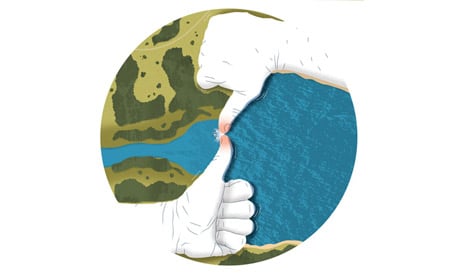THUMBS UP
There are 84,000 dams in the U.S. that provide flood control, drinking water, agricultural irrigation, hydropower, and recreation. Dams are engineered structures—like roads, bridges, and railroads—that make our high quality of life possible. Most dams that exist in the U.S. were constructed between 1950 and 1990. As with much U.S. infrastructure, many existing river dams are aging and in need of repair, rehabilitation, or even removal if they have out-lived their original purposes.
Hydropower is one of the crucial uses for dams, but less than 3 percent of existing dams produce hydroelectricity. Hydropower is the largest source of renewable electricity in the U.S. In addition to providing baseload and peaking power, hydropower projects also keep electrical transmission systems working smoothly.
The potential adverse impacts of dams are well documented, to be sure. These may include altered stream flow, habitat degradation, blockage of the upstream and downstream migrations of fish, mortality of fish passing through turbines, and lower rates of dissolved oxygen downstream of dams.
Over the last several decades, however, an extensive regulatory system has been developed to detect and correct such problems. For example, the Low Impact Hydropower Institute (LIHI) operates a voluntary certification process that identifies hydropower projects that have reduced their impacts and are investing in improvements in their local rivers. LIHI evaluates projects based on specific criteria: water release patterns below the project, water quality, fish passage, protection of threatened/endangered species, cultural resources, recreation, and requests for dam removal. More than 100 projects in 27 states have satisfied all of the LIHI criteria.
The fact that dams have the potential for adverse effects cannot be denied, but many of these can be reduced or eliminated with good siting and operation, plus modern mitigation practices. When dams are well managed, their net benefits are strongly positive.
Dr. Michael J. Sale is the executive director for the Low Impact Hydro Institute.
THUMBS DOWN
Wild rivers—ones that run free from headwaters to confluence—have nearly been wiped from the map and from our imagination. “Working” rivers—rivers with dams—have been replacing them. Modern dams, permanent and concreted, are the most charismatic of the giant water projects: nameable, decorated, architectural, triumphant, wired. The Army Corps of Engineers and the Bureau of Reclamation have practiced other similar techniques of reshaping terrain, including levees, canals, pipelines, jetties. Dams might be the most devastating.
Dams disrupt natural systems and thwart the work of rivers. Dams block fish runs and seasonal flood patterns—thus also their redistribution of nutrients, like marine nitrogen delivered by salmon to feed forests far inland. Hydroelectricity and irrigation are far more expensive when we count down-the-line costs of blocking forest regrowth, aquifer recharge, and topsoil renewal. Instead, dams encourage unsustainable growth, such as the mirage-metropolises of Phoenix and Las Vegas. Out-of-place agriculture makes deserts bloom briefly, but then leaves fields salted, palms wilting.
Dams displace people, often indigenous people and powerless people, from their river lifelines. In Tennessee and Kentucky, I grew up loving TVA lakes, not knowing that those lakes had drowned fertile bottomlands, homes, graveyards, living creeks, and human memories. The lakes were controlled and speedboat-clogged, with stinking bathtub-rings of stripped chert and shale.
The same story can be found across the country and around the world. In California, the Winnemem Wintu tribe fights a Shasta Dam add-on that will flood vital sacred sites. The Winnemem’s ongoing displacement is mirrored in language endangerment; only a few fluent speakers remain. In China, Three Gorges dam has displaced over one million people. Worldwide, dams also displace democracy. Dams are built as required elements of World Bank and IMF deals that rarely benefit the local people. Most of the generated hydropower is delivered to big cities, not the rural villages displaced by the dams.
Dams are made to fail. Huge reservoir surfaces mean terrible annual evaporation losses. Even the largest reservoirs silt up; Hoover Dam’s reservoir has less than 100 years left. Because of dams’ intense resource concentration, it’s an expensive failure. And dam collapse is nightmarish: catastrophic release of scouring grit, heavy metals, and tainted mud down-river.
Dams are not the solution to our energy crisis. Solar and wind can provide far more reliable, long-term energy than hydropower with far fewer environmental costs.
Wild, free-flowing rivers also provide the best recreation, whether you’re an angler, whitewater paddler, or swimming hole enthusiast. Rather than hordes of pollution- spewing speedboats on artifical lakes, the waters of Appalachia can once again run free and clean. The Blue Ridge is one of the world’s most ideal spots for wild, free-flowing rivers enjoyed by anglers, kayakers, and hikers—as well as by healthy, intact, abundant ecosystems.
It’s hard to see our way past dams to rivers that will really work again. But dam removal projects are gaining popularity. Once dams go, we’ll rediscover the wonders of wild, clear rivers teeming with fish.
July Cole is co-editor of Dam Nation: Dispatches from the Water Underground.







